Elizabeth Andrews's Blog, page 22
February 16, 2014
Heres a lttle ditty....
Oh my god the sun is shining! if that is not enough to make you smile try reading this..
Found this piece of advice in The Perpetual Almanack, an indispensable tool!
Cut nails on a Monday, cut them for healthCut them on a Tuesday, cut them for wealthCut them on a Wednesday, cut them for newsCut them on a Thursday, a pair of new shoesCut them on a Friday, cut them for sorrowCut them on a Saturday, see your true love tomorrowBut cut them on a Sunday, your safety seekFor old Nick'll have you the rest of the week!
Found this piece of advice in The Perpetual Almanack, an indispensable tool!
Cut nails on a Monday, cut them for healthCut them on a Tuesday, cut them for wealthCut them on a Wednesday, cut them for newsCut them on a Thursday, a pair of new shoesCut them on a Friday, cut them for sorrowCut them on a Saturday, see your true love tomorrowBut cut them on a Sunday, your safety seekFor old Nick'll have you the rest of the week!
Published on February 16, 2014 02:33
February 14, 2014
No matter the weather
We have just taken part in The Enchanted Market in Wokingham, first time we have done this one. It was great and we had a wonderful time. Although worried about getting up there and back due to the appalling weather we actually had a good trip both ways, the sun smiling on both the journeys. Met some lovely people! and look forward to seeing them again.

We have been lucky so far in this part of Somerset, we have avoided the flooding. Not so lucky the rest of the county and other parts of Britain. My heart goes out to them and well done to all the volunteers that have been helping.
In the fens of Cambridgeshire due to the nature of the landscape flooding has always been a problem; one of their water spirits called The Tiddy Mun was held responsible for the flooding and could be appealed to to withdraw the flood waters.He lives in the deep stagnant pools of the fens and only comes out at night when the mists are rising over the water.
When the waters start to rise and threaten the homes of the fenlanders, they call from their doorsteps to the Tiddy Mun to cal back the waters.
'Tiddy Mun wi' out a nameTha watters thruff'
When he answers, calling like a peewhit, they know that by morning the waters will have receded.In the 17th century a drainage program was started, this so angered the Tiddy Mun that he called down a pestilence on the area, causing animals and children to sicken and die. The locals managed to appease the water spirit by pouring offerings of water and ale into the dykes and apologising to him for the damage caused.
'Tiddy Mun, wi' out a nameHere's watter for theeTak thy spell undone'
Perhaps we should all take a leaf out of their book and start apologising to the nature spirits for the damage we have caused.

We have been lucky so far in this part of Somerset, we have avoided the flooding. Not so lucky the rest of the county and other parts of Britain. My heart goes out to them and well done to all the volunteers that have been helping.
In the fens of Cambridgeshire due to the nature of the landscape flooding has always been a problem; one of their water spirits called The Tiddy Mun was held responsible for the flooding and could be appealed to to withdraw the flood waters.He lives in the deep stagnant pools of the fens and only comes out at night when the mists are rising over the water.
When the waters start to rise and threaten the homes of the fenlanders, they call from their doorsteps to the Tiddy Mun to cal back the waters.
'Tiddy Mun wi' out a nameTha watters thruff'
When he answers, calling like a peewhit, they know that by morning the waters will have receded.In the 17th century a drainage program was started, this so angered the Tiddy Mun that he called down a pestilence on the area, causing animals and children to sicken and die. The locals managed to appease the water spirit by pouring offerings of water and ale into the dykes and apologising to him for the damage caused.
'Tiddy Mun, wi' out a nameHere's watter for theeTak thy spell undone'
Perhaps we should all take a leaf out of their book and start apologising to the nature spirits for the damage we have caused.
Published on February 14, 2014 01:48
January 16, 2014
Back to normal...
The computer died over Christmas, which meant we had a very relaxed time and I had no work to do so it was nice! But now with the addition of a new all singing all dancing machine I am up and running again.
Just in time to promote my article in The Somerset Life exploring the folklore of Somerset.
Also coming up in Feb, on the 8th, is the Enchanted Market: it is being held at the Pinewood Bar and Cafe, Old Wokingham Road, Wokingham, Berks R940 3AQ.There will be stalls, talks, workshops, healers and demos. Live music will be provided by The Dolmen, Cephalodidge and Spriggan. I will be having a stall there for book signings and selling artwork. Hope to see you there!
Just in time to promote my article in The Somerset Life exploring the folklore of Somerset.
Also coming up in Feb, on the 8th, is the Enchanted Market: it is being held at the Pinewood Bar and Cafe, Old Wokingham Road, Wokingham, Berks R940 3AQ.There will be stalls, talks, workshops, healers and demos. Live music will be provided by The Dolmen, Cephalodidge and Spriggan. I will be having a stall there for book signings and selling artwork. Hope to see you there!
Published on January 16, 2014 01:57
December 15, 2013
Book Giveaway
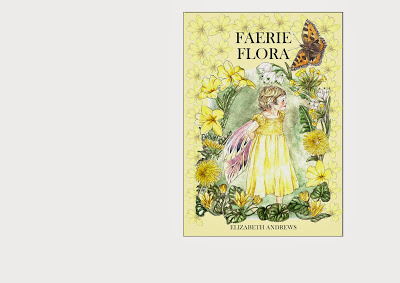 Book GiveawayI am interested in any quirky, funny, or downright scary faerie stories or anecdotes that you might have. If you have met one of the inhabitants of the land of Fae even better! So please share with us on this site and I will present a copy of Faerie Flora to the most interesting or funniest. So sharpen your pencils, flex your fingers and get to it.Looking forward to your stories!
Book GiveawayI am interested in any quirky, funny, or downright scary faerie stories or anecdotes that you might have. If you have met one of the inhabitants of the land of Fae even better! So please share with us on this site and I will present a copy of Faerie Flora to the most interesting or funniest. So sharpen your pencils, flex your fingers and get to it.Looking forward to your stories!
Published on December 15, 2013 06:27
December 12, 2013
St Finnians Night
St Finnians Night ,12th Dec, is celebrated in the Scottish Highlands and Islands: it is very unlucky to go to bed supper less on this night, any one who did so was likely to be carried away over the rooftops by the faeries!According to a Minster living in Barnstaple Devon. 1683 via a letter to a friend: 'Francis Fry was returning from work when he was caught by a female spectre who grabbed him by the skirts of his doublet and carried him into the air... and about half an hour later he was whistling and singing from the middle of a quagmire. Coming to himself an hour after he was found, he solemnly protested that the daemon carried him so high that he could see his Masters house underneath him no bigger than a hay cock... he prayed to God not to suffer the Devil to destroy him and he was then suddenly set down in that quagmire. The workmen found one of his shoes on one side of the house and the other on the other side; his perriwig was espied next morning hanging in the branches of a tall tree.'
Published on December 12, 2013 08:43
November 30, 2013
Fairyland
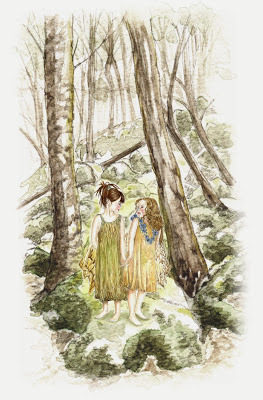
Fairyland is generallly believed to be a beautiful place where perpetual summer reigned. Gervase of Tilbury tells how a Derbyshire swineherd followed a sow through a cave and came to a country where all were reaping, though the Derbyshire hills were covered in snow. Sometimes this fairy land was lit by supernatural means, no sun or moon being visible.In a Cornish folktale, a young woman called Cherry from Zennor, takes service with an unknown gentleman who brings her to an underground country lit by a strange and lovely light. Here she has to tend a little boy and it is not until she rubs some of his ointment on her own eyes that she realises she is in faerieland. As soon as her master knows that she can see him as he really is he transports her back to Cornwall, leaving her on the exact spot where they first met. And she is never again able to find her way to his house.
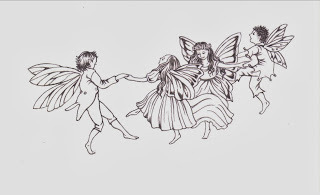 Numerous stories tell of people who have danced with the faeries for they thought was just a few hours and in fact was a year and a day. Two men met the faeries in a lonely place; one joined in with their dance but the other returned home. When his friend did not appear, he was accused of murder but managed to stave off arrest until a year and a day after meeting the faeries. He escaped taking a knife with and headed back to the place where they met the faeries. There he saw his friend dancing tirelessly in the faerie circle. He flung his knife into the ring seized his friend and manged to drag him away. His friend was astonished to hear what had happened, as he though he had only been dancing for a couple of hours.A more tragic tale is that of King Herla who was invited to the wedding of the faerie King. Herla and his men attended the magnificent feast held in the palace which was entered through a cave. After three days of feasting Herla prepared to leave for home. The Faerie King gave him a small hound and warned him that none of his company must alight from their horses until the hound leaps to the ground. When Herla reached his home he found everything changed, old landmarks had changed, the people spoke a strange language and his family and friends were not to be found. He asked a shepherd for news of his Queen and the man replied that he knew nothing of her except that two hundred years ago there was Queen of that name whose husband had disappeared and never seen again. In the meantime the Saxons had invaded Britain and were now the rulers of the country. The three days in faerieland had been three hundred years on earth and the world that Herla knew had vanished. At this terrible news some of his men leapt from their horses and were immediately turned to dust. The rest with the King at their head wandered hopelessly through the land seeking refuge. Some say that they can still be met riding over the hills, but according to Walter Map they all plunged into the River Wye and perished in the reign of Henry II.
Numerous stories tell of people who have danced with the faeries for they thought was just a few hours and in fact was a year and a day. Two men met the faeries in a lonely place; one joined in with their dance but the other returned home. When his friend did not appear, he was accused of murder but managed to stave off arrest until a year and a day after meeting the faeries. He escaped taking a knife with and headed back to the place where they met the faeries. There he saw his friend dancing tirelessly in the faerie circle. He flung his knife into the ring seized his friend and manged to drag him away. His friend was astonished to hear what had happened, as he though he had only been dancing for a couple of hours.A more tragic tale is that of King Herla who was invited to the wedding of the faerie King. Herla and his men attended the magnificent feast held in the palace which was entered through a cave. After three days of feasting Herla prepared to leave for home. The Faerie King gave him a small hound and warned him that none of his company must alight from their horses until the hound leaps to the ground. When Herla reached his home he found everything changed, old landmarks had changed, the people spoke a strange language and his family and friends were not to be found. He asked a shepherd for news of his Queen and the man replied that he knew nothing of her except that two hundred years ago there was Queen of that name whose husband had disappeared and never seen again. In the meantime the Saxons had invaded Britain and were now the rulers of the country. The three days in faerieland had been three hundred years on earth and the world that Herla knew had vanished. At this terrible news some of his men leapt from their horses and were immediately turned to dust. The rest with the King at their head wandered hopelessly through the land seeking refuge. Some say that they can still be met riding over the hills, but according to Walter Map they all plunged into the River Wye and perished in the reign of Henry II.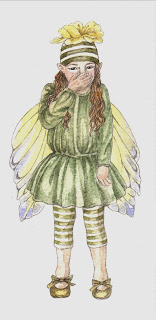
Published on November 30, 2013 07:06
November 28, 2013
Folklore of Mistletoe
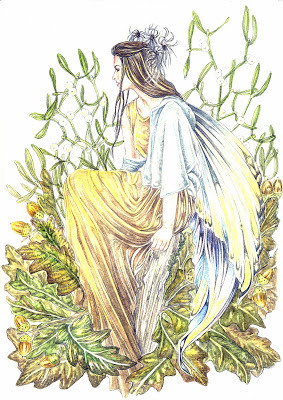
Mistletoe is one of the most popular plants for decorating the house at Christmas along with Holly and Ivy, and apart from been used as a decoration the plant has healing properties as well.
This is an excerpt from 'Faerie Flora'The mistletoe that grows on the oak was sacred to the ancient Celts. it would be cut on the sixth night of the new moon at midsummer and the winter solstice by white robed priests. Using a golden sickle or knife the plant would fall into a cloth held by members of the order, taking care that the sacred plant did not touch the ground. Traditionally two white bulls would be sacrificed at the same time.Sprigs of mistletoe would be distributed for the protection of homes against thunder and lightening.The plant was considered to be one of the most magical as the Celts believed that it bestowed life and fertility and the white berries contained the sperm of the gods.
 Decorating the home with mistletoe is an important part of the Christmas festivities; this is a survival of the Druid traditions, but the 'kissing under the mistletoe' has its origins in the Greek festivals Saturnalia, which is usually held during the Yule season to celebrate the birth of Saturn.One berry is removed with each kiss until none remain; any young girl standing underneath a bunch of mistletoe could not refuse to be kissed otherwise she would not be married in the following year. In some parts of England it is customary to burn the mistletoe on the twelfth night, otherwise all the young people who had kissed beneath the mistletoe would never marry.In Worcestershire kissing bunches were kept hanging from the beams all year until replaced by new ones at Christmas. The old bunches were then burnt, a steady flame indicates a faithful husband and a spluttering flame an irritable one!
Decorating the home with mistletoe is an important part of the Christmas festivities; this is a survival of the Druid traditions, but the 'kissing under the mistletoe' has its origins in the Greek festivals Saturnalia, which is usually held during the Yule season to celebrate the birth of Saturn.One berry is removed with each kiss until none remain; any young girl standing underneath a bunch of mistletoe could not refuse to be kissed otherwise she would not be married in the following year. In some parts of England it is customary to burn the mistletoe on the twelfth night, otherwise all the young people who had kissed beneath the mistletoe would never marry.In Worcestershire kissing bunches were kept hanging from the beams all year until replaced by new ones at Christmas. The old bunches were then burnt, a steady flame indicates a faithful husband and a spluttering flame an irritable one!In times past Mistletoe was forbidden in churches as it was seen as a heathen plant; but at on time in York cathedral it received full honours. It was ceremonially carried to the high altar on Christmas Eve after which a universal pardon and liberty for all was proclaimed at the four gates of the city for as long as the branch lay on the alter.
The mistletoe is known as the plant of peace; especially to the Scandinavians it is sacred. This has its origins in the legend of Freya/ Frigga the Goddess of beauty, love and marriage. Frigga was the wife of Odin. Legends tell that when she shook out her bedding snow would fall to earth. She was also the goddess of divination and she forsaw the death of her son Baldur. He was shot by a dart made of mistletoe and died, for three day every element of the earth, air fire and water tried to revive him. But it was Frigga who managed to restore him to life, her tears of joy turned into the white berries of the mistletoe. And for ever after warring factions would make peace under a branch of mistletoe.
The practice of this strange custom in York using the plant makes sense when you realise the city was for nearly a hundred years the capital of the Scandinavian Kingdom founded by Halfdan in 875.
Published on November 28, 2013 00:59
November 23, 2013
Cristmas tree
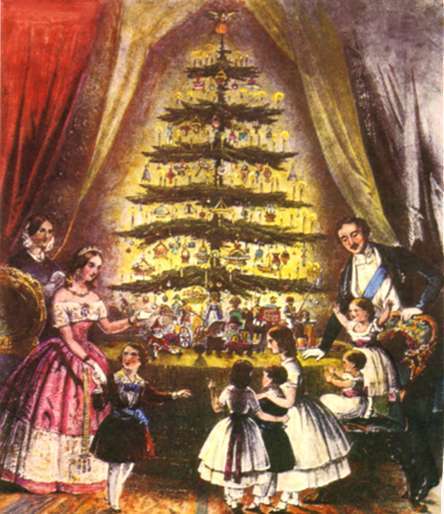
Have you set up your Christmas Tree yet? I haven't, I resist until a couple of weeks before the big day.Then I crawl into the attic and try and find the boxes of ornaments that have disappeared under a year'sworth of clutter, and why do the wires of the fairy lights always get tangled?But never mind...here;s a bit of waffle about Christmas trees!The traditional decoration in England was always the Yule Log, the earliest mention of a Christmas Tree was in 1829. There is a note in Grevilles Diary in which he describes three little Christmas trees he saw at Pashanger. Princess Lieven was apparently responsible for this spectacle, 'as is customary in Germany.'Prince Albert is usually credited with the introduction of Christmas Trees, starting the custom at Windsor in 1841, although George III's wife Queen Charlotte introduced a Christmas tree at a party she gave for children in 1800;but the custom did not at first spread much beyond the royal family. Queen Victoria as a child was familiar with the custom and a tree was placed in her room every Christmas. In her journal for Christmas Eve 1832, the delighted 13-year-old princess wrote, "After dinner... we then went into the drawing-room near the dining-room... There were two large round tables on which were placed two trees hung with lights and sugar ornaments. All the presents being placed round the trees.After her marriage to her German cousin Prince Albert by 1841 the custom became even more widespread throughout Britain. In 1847, Prince Albert wrote: "I must now seek in the children an echo of what Ernest [his brother] and I were in the old time, of what we felt and thought; and their delight in the Christmas-trees is not less than ours used to be". In 1848 The Illustrated London News described the trees in Windsor Castle in detail and showed the main tree, surrounded by the royal family, on its cover. In fewer than ten years their use in better-off homes was widespread. By 1856 a northern provincial newspaper contained an advert alluding casually to them, as well as reporting the accidental death of a woman in Somerset, whose dress caught fire as she lit the tapers on a Christmas tree. They had not yet spread down the social scale however, as a report from Berlin in 1858 contrasts the situation there where "Every family has its own" with that of Britain, where Christmas trees were still the preserve of the wealthy or the "romantic".A Saints Day particularly associated with Christmas is St Thomas's Day 21st Dec, although he has no particular association with the day itself it is the Winter Solstice.'St Thomas Grey, St Thomas GreyLongest night and shortest day'Uptil until the second world war women went a 'Thomassing' or 'agooding' going from house to house to beg for wheat to make Christmas cakes and bread. Each householder was obliged to hand over a pint of wheat which was then taken to the village mill to be ground into flour without charge. In return for the donation of grain a sprig of holly or mistletoe would be given. In Staffordshire the clergyman also gave the women each a shilling and in some parishes a collection was taken in Church and called St Thomases Dole.
Published on November 23, 2013 06:03
November 19, 2013
Mummers
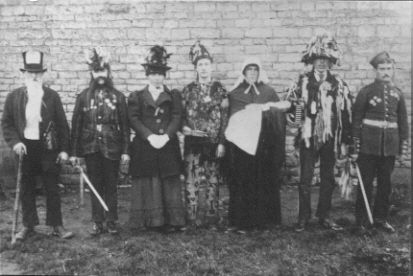
Mumming was also popular around Christmas time especially on Christmas Eve. Popular throughout the country and usually enacted simple stories such as King George who usually kills the Turkish Knight or the King of Egypt or some such villain. St George was the original hero but then appeared as King George, probably influenced by the reigns of the four Georges. He was usually responsible for the death of another character, usually the comic relief, but all was well at the end when a Doctor would appear and restore life to all the characters in the play.The mummers usually followed this simple ethos of good triumphing over evil or it was the rebirth of spring at the beginning of the year. Originally pagan in origin this has been performed for at least eight hundred years and is now the only example of pre- reformation folk drama left in this country.The Troupe of Mummers would walk around the district visiting various houses along the way and performing in their play in the kitchen or hall of the residence, probably imbibing many pints of cider and beer along the way. So by the end of the evening many of the verses and songs would have been rather rude!

Published on November 19, 2013 06:13
November 17, 2013
Christmas customs now long gone
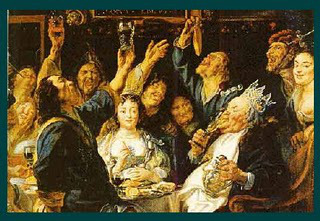
There was a custom in Gloucestershire that as part of the Wassailers at Christmas they would be accompanied by a man wearing a sack with his head thrust into the hollowed out head of a bull." The Bull, shaggy head with horns complete, shaggy coat and eyes of glass, was wont to appear, uninvited, at any Christmas festivities. None knew when he might or might not appear. He was given the freedom of every house and allowed to penetrate into any room, escorted by his keeper. The whole company would flee before his formidable horns, the more so as towards the end of the evening, neither the Bull nor his keeper could be certified as strictly sober. The Christmas Bull is now obsolete, but up to forty years ago, he was recognised custom." note this was written about the time of the second world war.'Dorset up along and Down along'With the onset of the war many customs such as these were put to one side; however once peace reigned they were never resurrected, mores the pity!Another similar custom was the Hoddening Horse, although he did not invade houses in quite the same manner he toured the villages with a band of young men and boys, prancing in front of open doorways. He was covered in a white sheet and wore a horses head whose jaws snapped ferociously open and shut on hinges. This was a winter custom, taking place around Christmas in some districts and All Hallows Eve in others.
Published on November 17, 2013 08:01



